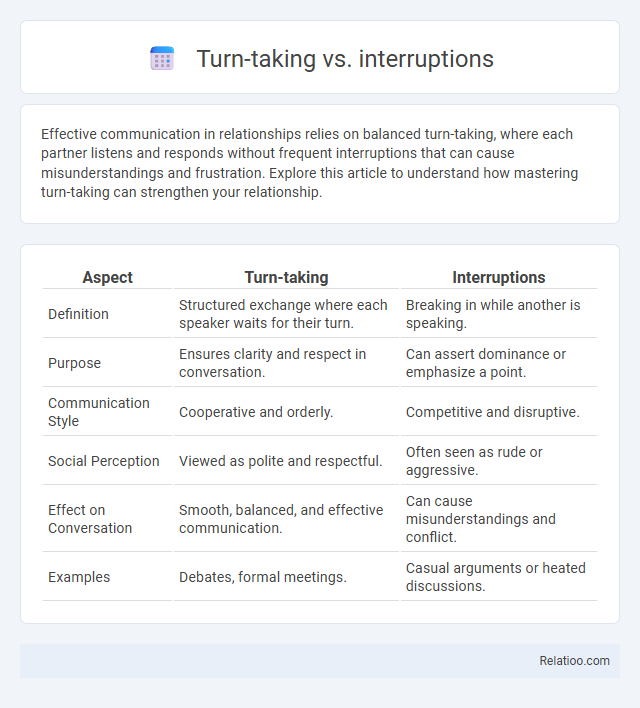Effective communication in relationships relies on balanced turn-taking, where each partner listens and responds without frequent interruptions that can cause misunderstandings and frustration. Explore this article to understand how mastering turn-taking can strengthen your relationship.
Table of Comparison
| Aspect | Turn-taking | Interruptions |
|---|---|---|
| Definition | Structured exchange where each speaker waits for their turn. | Breaking in while another is speaking. |
| Purpose | Ensures clarity and respect in conversation. | Can assert dominance or emphasize a point. |
| Communication Style | Cooperative and orderly. | Competitive and disruptive. |
| Social Perception | Viewed as polite and respectful. | Often seen as rude or aggressive. |
| Effect on Conversation | Smooth, balanced, and effective communication. | Can cause misunderstandings and conflict. |
| Examples | Debates, formal meetings. | Casual arguments or heated discussions. |
Introduction to Conversational Dynamics
Turn-taking is a fundamental mechanism in conversational dynamics that ensures smooth and orderly exchanges between speakers by allocating speaking opportunities sequentially. Interruptions disrupt this flow by cutting off speakers before they have completed their contributions, often signaling issues like power imbalance or conversational tension. Understanding the distinctions between turn-taking and interruptions is crucial for analyzing communication patterns and improving interactional coherence in social and professional settings.
Defining Turn-Taking in Communication
Turn-taking in communication refers to the orderly exchange of speaking turns between participants, allowing each person to contribute without overlap or interruption. It establishes clear boundaries for when one speaker finishes and another begins, facilitating mutual understanding and effective interaction. Interruptions occur when these boundaries are breached, disrupting the flow and potentially causing misunderstandings or conflict.
Understanding Interruptions: Types and Motives
Interruptions can be classified into types such as cooperative, intrusive, and competitive, each reflecting different conversational motives. Cooperative interruptions aim to support or clarify, while intrusive interruptions disrupt the speaker without intent to help, and competitive interruptions seek to dominate the dialogue. Understanding these distinctions is crucial for managing communication dynamics and improving conversational turn-taking strategies.
Cultural Perspectives on Turn-Taking
Cultural perspectives significantly influence norms around turn-taking and interruptions during conversations, affecting communication dynamics across societies. In some cultures, overlapping speech and interruptions indicate engagement and enthusiasm, while in others, strict turn-taking emphasizes respect and listening. Understanding these cultural nuances helps you navigate conversations more effectively and avoid misinterpretations in multicultural settings.
Power Dynamics and Interruptions
Turn-taking structures in conversations establish a framework for equitable dialogue, but power dynamics often influence who controls these exchanges, with dominant participants frequently interrupting to assert authority. Interruptions can function as a strategic tool for maintaining or challenging power, reflecting underlying social hierarchies and communication control. Your awareness of these patterns is crucial for navigating conversations where voices may be marginalized or amplified based on positional power.
Impact on Effective Communication
Turn-taking ensures that each participant in a conversation has an opportunity to speak, promoting clarity and mutual understanding, while interruptions often disrupt the flow and can lead to misunderstandings or conflicts. Your ability to navigate turn-taking effectively fosters respectful dialogue and strengthens relationships by allowing ideas to be fully expressed and considered. Managing interruptions with sensitivity enhances communication efficiency and maintains a positive conversational atmosphere.
Gender Differences in Conversational Flow
Gender differences in conversational flow reveal that women typically engage in more cooperative turn-taking, fostering smooth transitions and minimizing interruptions, while men are more prone to interrupting as a means of asserting dominance or control. Research indicates women use overlapping speech to show support and connection, contrasting with men's interruptions, which often disrupt dialogue and influence conversational dynamics. Your awareness of these patterns can enhance communication effectiveness by adapting your conversational style to create more equitable and respectful exchanges.
Strategies for Managing Interruptions
Effective strategies for managing interruptions involve recognizing the difference between smooth turn-taking and disruptive interruptions. Techniques such as setting clear conversational norms, using nonverbal cues like hand signals, and politely redirecting the conversation encourage equitable participation. Employing active listening skills and maintaining a respectful tone helps minimize conflicts and fosters a collaborative communication environment.
The Role of Technology in Turn-Taking
Technology significantly shapes turn-taking in communication by facilitating smoother exchanges through tools like speech recognition and real-time transcription, which reduce interruptions and improve conversational flow. Platforms such as video conferencing software often incorporate features like "raise hand" buttons and speaking queues, helping manage turn-taking in virtual meetings and minimizing overlap or interruptions. Advanced AI algorithms analyze speech patterns to dynamically allocate speaking turns, enhancing efficiency and clarity in both formal and informal dialogues.
Balancing Turn-Taking and Spontaneity
Balancing turn-taking and spontaneity requires fostering a conversational flow where You can contribute seamlessly without rigidly adhering to strict turn-taking rules or allowing frequent interruptions that disrupt communication. Effective communication balances structured turn-taking with natural interjections, ensuring all participants feel heard while maintaining the conversation's dynamic energy. Mastering this balance improves dialogue coherence, listener engagement, and mutual understanding in both professional and casual settings.

Infographic: Turn-taking vs Interruptions
 relatioo.com
relatioo.com